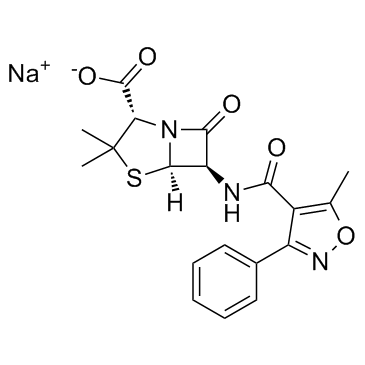Oxacillin sodiuM salt

Oxacillin sodiuM salt structure
|
Common Name | Oxacillin sodiuM salt | ||
|---|---|---|---|---|
| CAS Number | 1173-88-2 | Molecular Weight | 423.418 | |
| Density | 1.49g/cm3 | Boiling Point | 686.8ºC at 760 mmHg | |
| Molecular Formula | C19H18N3NaO5S | Melting Point | 188ºC | |
| MSDS | Chinese USA | Flash Point | 369.2ºC | |
|
Antibacterial compounds from Salvia adenophora Fernald (Lamiaceae).
Phytochemistry 110 , 120-32, (2015) From the aerial parts of Salvia adenophora Fernald four derivatives of 12-oxo-phytodienoic acid (1-4) together with five clerodane diterpenoids (5, 6, 8-10), and one known diterpene (7) have been isolated. Compounds 1-6 and 8-10 are described for the first ti... |
|
|
A new antibiotic kills pathogens without detectable resistance.
Nature 517(7535) , 455-9, (2015) Antibiotic resistance is spreading faster than the introduction of new compounds into clinical practice, causing a public health crisis. Most antibiotics were produced by screening soil microorganisms, but this limited resource of cultivable bacteria was over... |
|
|
Antimicrobial/anti-biofilm activity of expired blood platelets and their released products.
Postepy. Hig. Med. Dosw. 67 , 321-5, (2013) Although platelets are not part of the classical immune system, they have many features that indicate their role in the anti-infective host defense. They come into interactions with microorganisms, which results in co-aggregation and co-adhesion or destructio... |
|
|
Identification and typing of Salmonella enterica serotypes isolated from guinea fowl (Numida meleagris) farms in Benin during four laying seasons (2007 to 2010).
Avian Pathol. 42(1) , 1-8, (2013) The main problem for the local guinea fowl (Numida meleagris) traditional farming and raising system in north-east Benin is the high mortality rate of the keets (up to 70%) due to a combination of climatic, nutritional, hygienic and infectious causes. The pre... |
|
|
Superparamagnetic iron oxide nanoparticles (SPION) for the treatment of antibiotic-resistant biofilms.
Small 8(19) , 3016-27, (2012) Bacterial infections caused by antibiotic-resistant strains are of deep concern due to an increasing prevalence, and are a major cause of morbidity in the United States of America. In particular, medical device failures, and thus human lives, are greatly impa... |
|
|
Artesunate has its enhancement on antibacterial activity of β-lactams via increasing the antibiotic accumulation within methicillin-resistant Staphylococcus aureus (MRSA).
J. Antibiot. 66(6) , 339-45, (2013) Methicillin-resistant Staphylococcus aureus (MRSA) has now emerged as a predominant and serious pathogen because of its resistance to a large group of antibiotics, leading to high morbidity and mortality. Therefore, to develop new agents against resistance is... |
|
|
Restoration of antibiotic sensitivity in meticillin-resistant Staphylococcus aureus following treatment with a non-thermal atmospheric gas plasma.
Int. J. Antimicrob. Agents 41(4) , 398-9, (2013)
|
|
|
Epigallocatechin gallate induces upregulation of the two-component VraSR system by evoking a cell wall stress response in Staphylococcus aureus.
Appl. Environ. Microbiol. 78(22) , 7954-9, (2012) We previously found that a short exposure of Staphylococcus aureus to subinhibitory (SI) doses of epigallocatechin gallate (EGCG) results in increased cell wall thickness, adaptation, and enhanced tolerance to cell-wall-targeted antibiotics. In this study, th... |
|
|
β-Lactams increase the antibacterial activity of daptomycin against clinical methicillin-resistant Staphylococcus aureus strains and prevent selection of daptomycin-resistant derivatives.
Antimicrob. Agents Chemother. 56(12) , 6192-200, (2012) Methicillin-resistant Staphylococcus aureus (MRSA) has emerged to be one of the most important pathogens both in health care and in community-onset infections. Daptomycin (DAP) is a cyclic anionic lipopeptide recommended for treatment of skin infections, bact... |
|
|
Interplay of antibiotics and bacterial inoculum on suture-associated biofilms.
J. Surg. Res. 177(2) , 334-40, (2012) Biofilms are often antibiotic resistant, and it is unclear if prophylactic antibiotics can effectively prevent biofilm formation. Experiments were designed to test the ability of high (bactericidal) concentrations of ampicillin (AMP), vancomycin (VAN), and ox... |